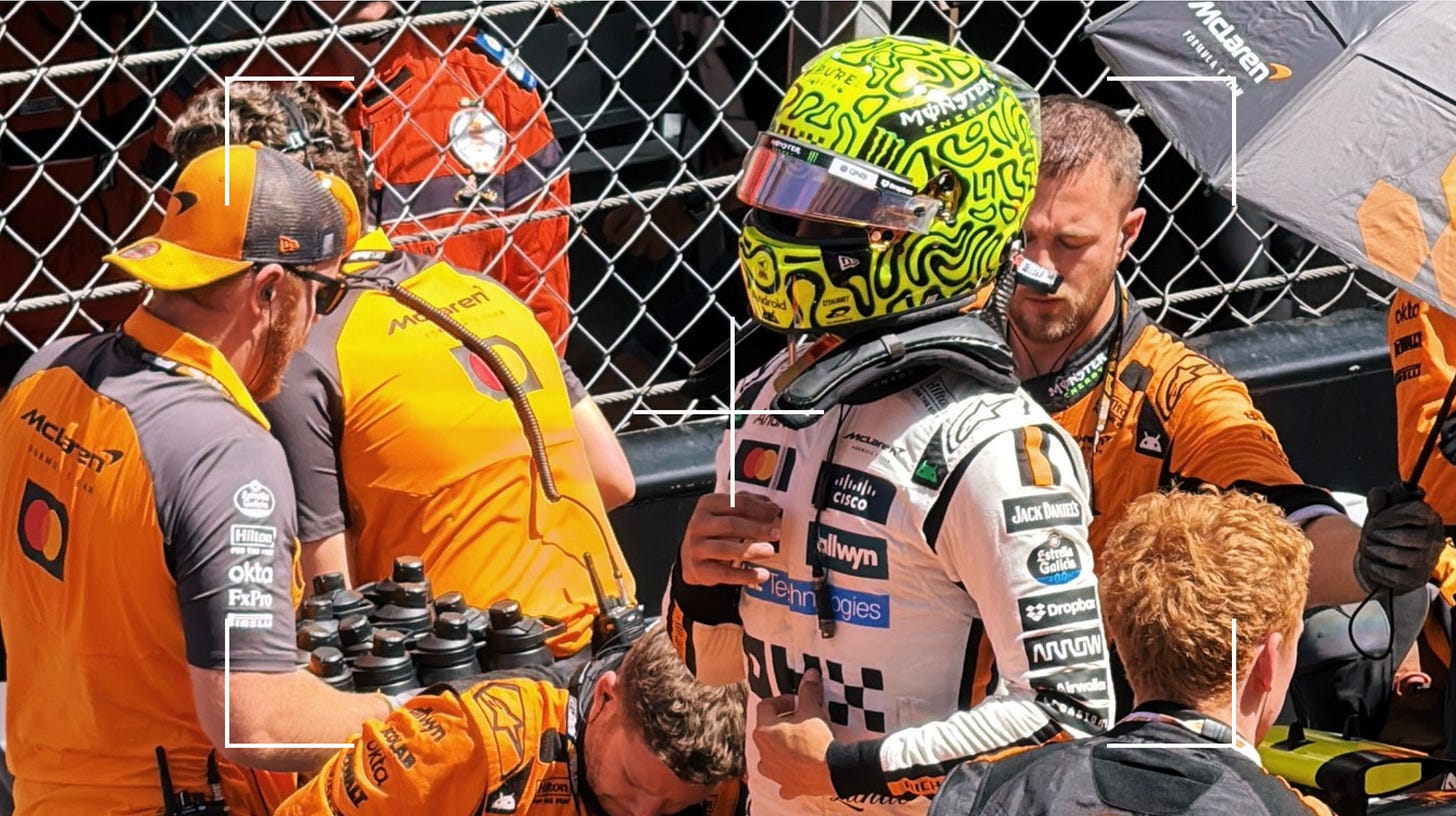Apple just paid F1 either way too much or way to little
Shift Happens #2 | Weekly pivots where motorsport collides with tech and culture.
Thank you for being here. You are receiving this email because you subscribed to Idée Fixe, the newsletter for curious minds. I’m Toni Cowan-Brown, a tech and F1 commentator. I’m a former tech executive who has spent the past five years on the floor of way too many F1, FE, and WEC team garages, learning about the business, politics, and technology of motorsports.
⏳ Reading time: 6 minutes
Shift Happens, weekly pivots where motorsport collides with tech and culture. Essentially, a roundup of the headlines in and around motorsport you should be aware of. I’m introducing this alongside my weekly deep dives. I hope you enjoy this new curated format.
The lead lap
Apple wants to fix sports broadcasting, and they want to start with Formula 1. After weeks of paddock rumours, Apple has officially secured the US broadcasting rights for Formula 1 in a five-year deal reportedly worth $140 million annually. The timing is striking, coming just days after Apple’s senior vice president Eddy Cue publicly stated that sports streaming “needs fixing” and that Apple doesn’t need to “do sports the way that they are.” True to that philosophy, Apple wants to reimagine how American fans will access F1 content. The existing F1TV service will disappear as a standalone app in the US, with F1 TV Premium instead being folded directly into the standard Apple TV subscription at $12.99 per month - no additional charge required. Certain races and all practice sessions will even be available for free within the Apple TV app, a notable departure from the additional subscription model Apple used for MLS.
The deal represents a calculated risk for both parties. F1 is willingly abandoning the standalone revenue it generated from F1 TV (on top of the $85-90 million annually from ESPN) in exchange for Apple’s $140 million per year and the promotional muscle of one of the world’s most powerful companies. The fact that F1 gave up this direct-to-consumer revenue stream suggests it wasn’t particularly substantial yet. Meanwhile, moving from ESPN’s broad sports distribution to Apple’s more limited reach presents short-term viewership risk, though you could argue ESPN never fully committed its promotional weight to F1 - perhaps indicating the sport remains a harder sell to American audiences than its recent growth suggests. Morgan Stanley characterised the deal as having “modest financial impact but strategic upside” for Apple, with the $700 million total commitment representing a tiny fraction of the company’s $3.9 trillion market cap.
Ultimately, F1 is betting that Apple will promote the sport with the same intensity it brought to marketing the F1 movie - at levels far beyond what Apple has managed with MLS, where playoff matches recently had to be made available to all subscribers to boost exposure. For Apple, this is another strategic toe-dip into live sports, but only where it can control the entire user experience and reimagine the broadcast model. Market reaction has been telling: F1’s stock dropped about 2% following the announcement, while Apple’s climbed 6%, suggesting investors see more upside for the tech giant than the racing series in this experimental partnership.
The number of the week
$140 million/per year is how much Apple will be paying Formula 1 for the broadcast rights in the USA. This is a five-year deal, so we are looking at a $700 million total deal. It is worth saying that neither F1 nor Apple have confirmed these numbers.
Three stories that need to be on your radar
Duct tape games. It never ceases to amaze me just how central sticky tape is in Formula 1. We’ve seen F1 cars duct-taped together at races. But this past weekend in Austin it was a different story altogether. Here’s what happened: Lando Norris has been using a piece of tape placed on the pit wall to help him perfectly align his front wheels on the grid. Drivers are penalised if they do not correctly position their cars on the grid - and penalties have been given out in the past. Drivers have a restricted view from the cockpit, making it almost impossible to see the grid box markings on the track surface. Trust me, I’ve sat in one of these cars and couldn’t see shit. This tape, positioned at roughly the driver’s head height, gives them a visual reference when pulling into their grid slot and thus helps them avoid positioning errors. McLaren apparently asked the FIA at the start of the season if they could use this tape trick, and it’s legal under F1’s sporting regulations. Red Bull apparently has been trying to remove this tape. So McLaren started using tamper-proof tape, as one does. This weekend, a Red Bull team member went back onto the grid after the formation lap had started to remove Norris’s marker tape. Pit marshals tried stopping him, but he didn’t react. As a result, Red Bull was fined €50,000 - but not for removing the tape itself, which technically isn’t illegal- rather for entering a prohibited area after the formation lap began. Both McLaren’s tape and Red Bull’s attempt to remove it exist in a grey zone of the regulations. Link
The autonomous cars have beaten the human benchmark time. The world’s most advanced autonomous racing teams have just completed a historic qualifying week in Abu Dhabi, with Italy’s Unimore team achieving what was once thought impossible - an autonomous race car beating a professional human driver’s benchmark time. The AI-powered vehicle completed a lap of Yas Marina Circuit’s North Configuration in 58.87 seconds, edging out the human record by seven hundredths of a second. Six elite teams from around the world have now qualified for the Grand Final on November 15 (where I will be in attendance). They’ll compete in an unprecedented six-car autonomous race for a $2.25 million prize pool. This is a glimpse into the future of AI development under extreme conditions. As these driverless race cars navigate split-second overtakes and avoid collisions at speeds approaching 300 km/h, they’re pushing artificial intelligence to its absolute limits. We will also witness a showdown that includes a human vs AI showcase with former F1 driver Daniil Kvyat. Link
President Ben Sulayem will run unopposed in FIA presidential race. In a press conference in Austin ahead of the race weekend, Tim Mayer announced to a room of journalists that “There will be only one candidate, the incumbent,”. There are in total three candidates on top of the incumbent, but the moment the official list of all candidatures for the WMSC was made public - i.e. all the candidates the presidential candidates can pick from to make up their presidential list - it became very quickly apparent that none of the three candidates would be able to mount a bid (this video explains why that is the case). So far, only Tim Mayer has officially withdrawn from the race, and he has questioned what had changed since the previous election, when more than 40 World Motor Sport Council candidates were available. What has baffled me since the start is that the requirements for the 2025 FIA elections, aka relevant deadlines and eligibility criteria for the presidential list and World Councils, are clear and available on the FIA website. This election cycle has been messy to say the least, and once this season is over, I am eager to look back at how we got here. Link
One video worth your time
Motorsport seems to have taken on a distinct shade of orange - or papaya if you are McLaren, and there’s a good reason why. 🧡
One [event] that caught my eye
Last week in Austin, I attended an intimate dinner hosted by Android (a McLaren Racing partner) and Aurora at La Piscina in the downtown Austin Proper hotel. What made the evening exceptional was the thoughtfully curated guest list and setting - it created genuine space for meaningful conversation and connection. Against the backdrop of race weekend’s typically frenetic, high-decibel events, this dinner stood out as something different: a moment of intentionality. It’s a model I wish more F1 brands and partners would embrace; prioritising quality engagement over spectacle. The massive, impersonal events that dominate the calendar may generate buzz (if they even manage to cut through the noise), but intimate experiences like this one deliver something far more valuable: real impact, valuable connections for those in attendance and a moment of learning and reflection.






Great breakdown of the Apple deal! I've been digging into the numbers too, and here's what's particularly interesting about that $140M figure:
ESPN was paying $85-90M annually, so Apple is paying roughly 55-64% more. But F1 is giving up F1 TV Pro standalone revenue in the US market. While F1 doesn't break out US-specific F1 TV numbers, we know that F1 TV generated $47M globally in 2021, subscribers grew 15% in 2024, and the US is their largest market. A conservative estimate puts US F1 TV revenue somewhere in the $15-25M range annually.
So F1's net gain isn't the full $50-55M difference between ESPN and Apple—it's more like $25-40M after accounting for lost F1 TV revenue. The real question: Is Apple getting a bargain for exclusive US rights that include F1 TV Premium bundled in, or did F1 correctly value Apple's promotional ecosystem at a premium worth surrendering their direct-to-consumer platform?
This is the kind of itemized breakdown I do weekly at THE RECEIPT—following F1's money while everyone else follows lap times. Apple TV Receipt drops Tuesday.